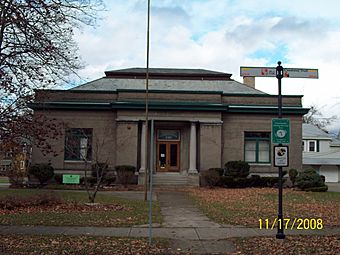Carnegie Library (North Tonawanda, New York) facts for kids
Quick facts for kids |
|
|
Carnegie Library
|
|

North Tonawanda Carnegie Library, November 2008
|
|
| Location | 249 Goundry St., North Tonawanda, New York |
|---|---|
| Built | 1903 |
| Architect | E. E. Joralemon |
| Architectural style | Classical Revival |
| NRHP reference No. | 95000851 |
| Added to NRHP | July 14, 1995 |
The Carnegie Library in North Tonawanda, New York is a special old building. It was built in 1903 with money from a very generous person named Andrew Carnegie. This library is located in Niagara County, New York. It's one of many libraries Carnegie helped build across the country.
Contents
What is a Carnegie Library?
Between 1885 and 1919, Andrew Carnegie, a very wealthy businessman, helped build almost 3,000 libraries. He believed that everyone should have access to books and learning. He gave money to towns and cities to build these libraries. In New York State alone, 107 Carnegie libraries were built.
The North Tonawanda Library
Andrew Carnegie gave $20,000 to help build the North Tonawanda library. This was a lot of money back then! The building is a low, one-story brick structure. It also has a basement. Its design is called Classical Revival. This style often looks like ancient Greek or Roman buildings.
Inside the Building
The inside of the library is very beautiful. It has nice wood paneling on the walls. You can see fancy plaster moldings and trim. The floors are made of mosaic tiles, which means they have small pieces of colored tile forming patterns. There is also a large stained glass skylight. This lets colorful light stream into the building.
From Library to Art Center
This building was used as a public library for many years. It served the community until 1976. After that, it found a new purpose. It became home to the Carnegie Art Center. This center is part of the Tonawandas' Council on the Arts. It helps bring art to the community.
A Historic Landmark
Because of its history and special design, the Carnegie Library was added to the National Register of Historic Places in 1995. This means it is recognized as an important historical site.



